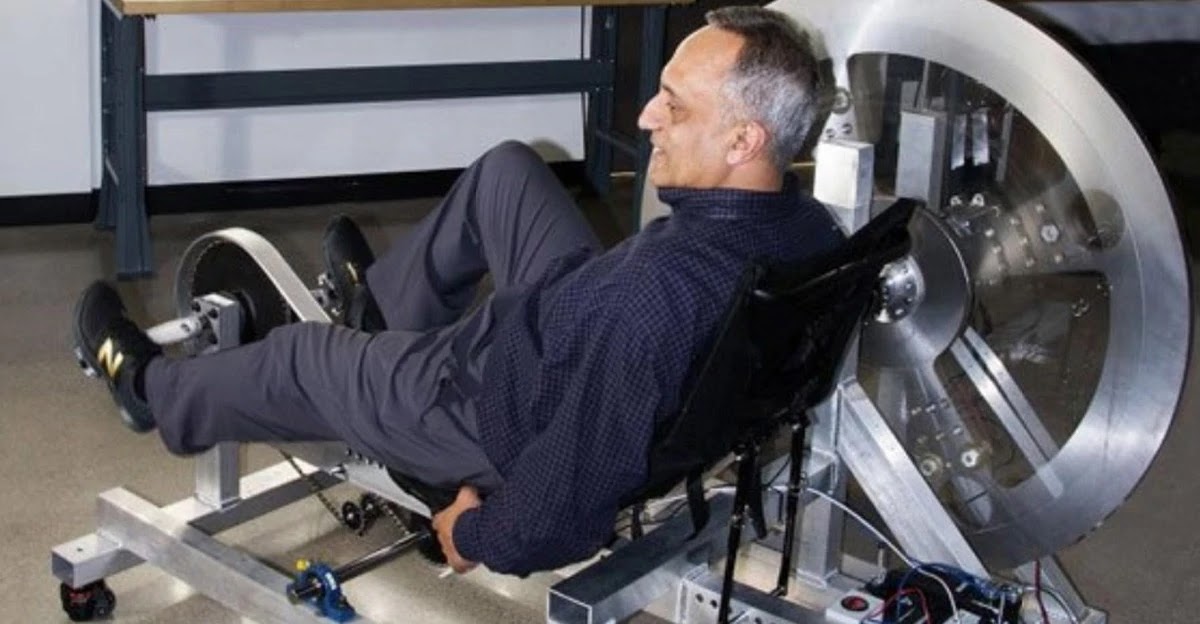Soon, Isaac Asimov’s legendary Foundation trilogy will be coming to HBO. But what do you need to know about this series, which explores questions of fate versus determinism and the cyclical nature of history? Here’s our complete primer on this enduring science-fiction classic.
Top image: Foundation and Empire, art by Chris Foss.
The news that Interstellar‘s Jonah Nolan would be writing and producing the adaptation broke last week, shortly after he expressed his admiration for Asimov’s opus in an interview withIndiewire:
I fucking love the Foundation novels by Isaac Asimov —they’re certainly not unknown, but that’s a set of books I think everyone would benefit from reading. That’s a set of books where the influence they have is just fucking massive; they have many imitators and many have been inspired by them, but go back and read those, and there are some ideas in those that’ll set your fucking hair on fire.
In fact, Foundation has inspired writers from Douglas Adams to George Lucas, and public figures as varied as Paul Krugman and Newt Gingrich. In 1966, the Foundation Trilogy received the Hugo Award for Best All-Time Series, beating out the Lord of the Rings. (Asimov himself confessed surprise at winning the award, believing, as many others, that the category had been explicitly created to honor Tolkien’s work.)
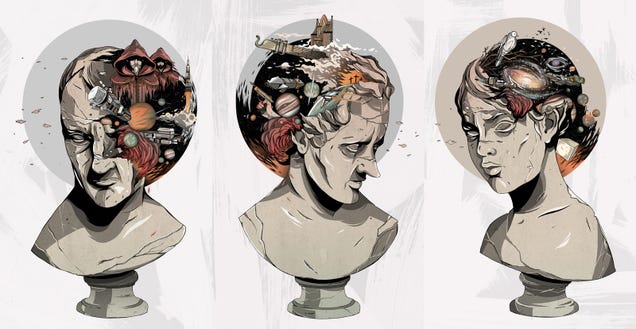
It’s an accomplishment all the more remarkable given that the story driving the Foundation Trilogy — an epic tale of the fall and rise of future galactic empires —contains virtually none of the usual tropes that are associated with science fiction. The novels span the entire galaxy, but no extraterrestrials make an appearance. It depicts the future history of human society, but it’s neither explicitly a utopian nor dystopian parable. There’s plenty of futuristic technology—from faster-than-light spacecraft to personal force fields—but all of this serves as the background, not the driver, of the plot. In fact, Foundation appears to contradict Asimov’s own definition of science fiction, as a “branch of literature which deals with the reaction of human beings to changes in science and technology.”
In this case, though, Asimov would later explain that he set out to create a genre he called “social science fiction.” He used the future as a template to explore a pivotal idea that we’ve been asking for centuries: Are there laws of human history as immutable as the laws of physics?
The Decline and Fall of the Galactic Empire
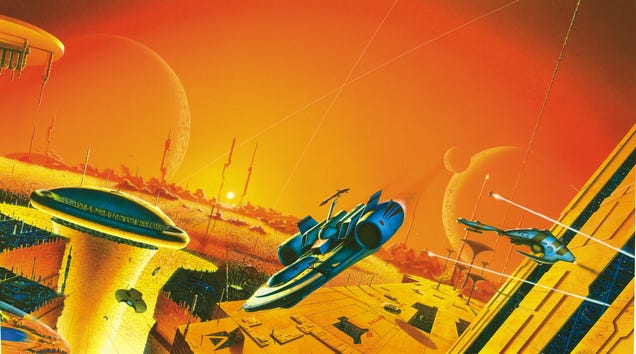
It’s not easy to summarize a series as massive in scope as Foundation. But, Josh Wimmer and Alasdair Wilkins do a first-rate job in a four-part exegesis of the books that they wrote for io9 in 2011:
The Foundation series began as a set of short stories Asimov wrote under the guidance of legendary Astounding Science Fiction editor John W. Campbell. The stories were inspired by Asimov’s reading of Edward Gibbon’s The Decline and Fall of the Roman Empire, and their premise is so simple, it feels almost inevitable.
There is a Galactic Empire, consisting of countless planets spread across millions of light-years. The brilliant Hari Seldon has used a science of his own invention, called psychohistory, to determine that the Empire is near collapse. Psychohistory is a blend of crowd psychology and high-level math. An able psychohistorian can predict the long-term aggregate behavior of billions of people many, many years in the future. (However, it only works with large groups: Psychohistory is almost useless for predicting the behavior of an individual. Also, it’s no good if the group being analyzed is aware it’s being analyzed — because if it’s aware, the group changes its behavior.)
The books that came to be called the original Foundation Trilogy (Foundation, Foundation and Empire, and Second Foundation) were not written as novels; they’re the collected Foundation stories Asimov wrote between 1941 and 1950. They deal chiefly with the “first” Foundation, based on the planet Terminus in the galaxy’s periphery. The stories are connected chronologically, but are separated by decades, and for the most part each features a different set of characters. The basic idea is always the same, though, at least in the beginning: The relatively tiny Foundation has to survive against a more powerful enemy, and it can only do so by recognizing and working with the historical forces contributing to its situation. Again, at least at first, every Foundation story centers on what is called a Seldon crisis — a convergence of apparently insurmountable external and internal problems. The crises were all predicted by Hari Seldon — who appears near the end of each story in hologram form to confirm that the Foundation has navigated the latest one correctly — but the Foundation itself isn’t given the benefit of his foreknowledge. After all, if they knew what he knew, their behavior wouldn’t be psychohistorically predictable!”
The work that inspired Asimov, Edward Gibbon’s multi-volume series, The Decline and Fall of the Roman Empire, published between 1776 and 1789, remains a masterpiece of historiography. Gibbon saw Rome’s fall not as a consequence of specific, dramatic events, but as the result of gradual transformations including the decline of civic virtue and the rise of Christianity, which made the Romans less vested in worldly affairs, shifting their attention towards the rewards waiting for them in the Kingdom of Heaven.
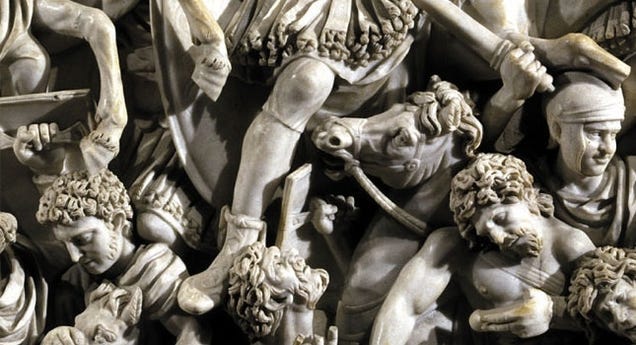
As Robert Kaplan has noted:
The Decline and Fall instructs that human nature never changes, and that mankind’s predilection for faction, augmented by environmental and cultural differences, is what determines history….The brilliance of the Decline and Fall lies in Gibbon’s ability to build a narrative out of individual agency and the surprises of history…..even as the sheer accumulation and repetition of events over centuries ultimately robs many an effective emperor (each with a distinct personality early in the story) of his identity in the reader’s mind, and as the initially successful restoration flows into the larger movement of decline. Only patterns, rather than individuals, endure at the end of the three volumes.
These ideas are manifest throughout Asimov’s novels. But the other influence on Asimov, which is often overlooked, is that he was immersed in studies of chemistry at the time he began writing his Foundation stories.
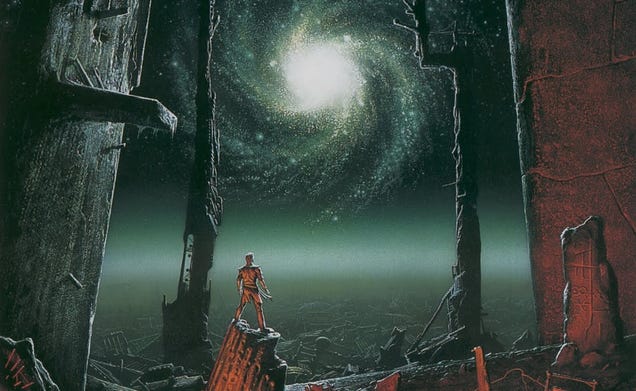
The creation of “psychohistory” was intended to be a melding of the physical and social sciences. As he explained in a 1987 interview published in the journal Science Fiction Studies:
I wanted to consider essentially the science of psychohistory, something I made up myself. It was, in a sense, the struggle between free will and determinism. On the other hand, I wanted to do a story on the analogy of The Decline and Fall of the Roman Empire, but on the much larger scale of the galaxy. To do that, I took over the aura of the Roman Empire and wrote it very large. The social system, then, is very much like the Roman imperial system, but that was just my skeleton.
At the time I started these stories, I was taking physical chemistry at school, and I knew that because the individual molecules of a gas move quite erratically and randomly, nobody can predict the direction of motion of a single molecule at any particular time. The randomness of their motion works out to the point where you can predict the total behavior of the gas very accurately, using the gas laws. I knew that if you decrease the volume, the pressure goes up; if you raise the temperature, the pressure goes up, and the volume expands. We know these things even though we don’t know how individual molecules behave.
It seemed to me that if we did have a galactic empire, there would be so many human beings—quintillions of them—that perhaps you might be able to predict very accurately how societies would behave, even though you couldn’t predict how individuals composing those societies would behave.
So, against the background of the Roman Empire written large, I invented the science of psychohistory. Throughout the entire trilogy, then, there are the opposing forces of individual desire and that dead hand of social inevitability.
The so-called “Seldon Crises” that Wimmer and Wilkins previously mentioned take on two forms: (1) Events unfold in such a way that there is only one clear path to take, or (2) The forces of history conspire to determine the outcome. But, the common factor is that free will doesn’t matter. The protagonists and antagonists believe their decisions will make a difference when, in fact, the future is already written.
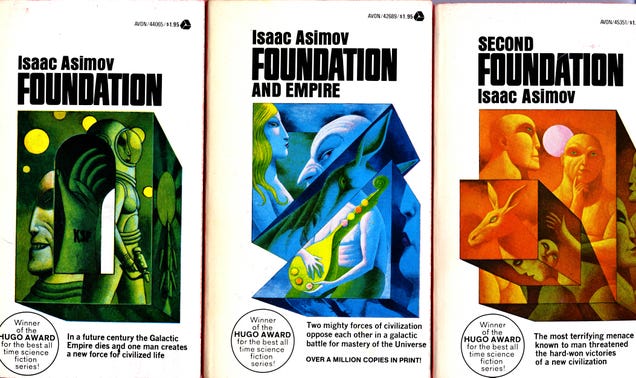
This idea is most explicitly stated in the second book of the trilogy, Foundation and Empire, which takes place about two centuries into the Foundation era.
General Bel Riose, the last great military leader of the old Galactic Empire, sets out to conquer the mysterious Foundation on behalf of the last strong emperor, Cleon II. The Empire is falling, no doubt, but these two men represent its last gasp of strength, and there is no one in the Foundation’s ossifying elite who can match them. Riose seeks out an elderly nobleman named Ducem Barr, who had previous dealings with the Foundation as a younger man in the first book. Although Barr has no love for the Empire, he is the closest thing the Empire has to an expert on the Foundation, and so Riose presses him into reluctant service.
Barr attempts to explain to Riose why his military campaign is doomed to failure:
Barr: Without pretending to predict the actions of individual humans, Seldon’s plan formulated definite laws capable of mathematical analysis and extrapolation togovern and predict the mass action of human groups….
Riose: You are trying to say that I am a silly robot following a predetermined course of destruction.
Barr: No, I have already said that the science had nothing to do with individualactions. It is the vaster background that has been foreseen.
Riose: Then we stand clasped tightly in the forcing hand of the Goddess of Historical Necessity.
Barr: Of Psychohistorical Necessity.
Riose: And if I exercise my prerogative of freewill? If I choose to attack next year, or not to attack at all? How pliable is the Goddess? How resourceful?
Barr: Do whatever you wish in your fullest exercise of freewill. You will still lose.
Riose: Because of Hari Seldon’s dead hand?
Barr: Because of the dead hand of the mathematics of human behavior that can neither be stopped, swerved nor delayed.
Riose: I’ll take that challenge. It’s a dead hand against a living will.
Initially, Riose seems to prove Barr wrong, as he achieves one victory after another. But then, all of a sudden, the war ends, when Riose is recalled and arrested by the Empire on charges of treason.
Barr explains how, in hindsight, Riose was doomed to failure:
There was a dead hand pushing all of us; the mighty general and the great Emperor….the dead hand of Hari Seldon.
A weak general could never have endangered us, obviously. A strong general during the time of a weak Emperor would never have endangered us, either; for he would have turned his arms towards a much more fruitful target. Events have shown that three-fourths of the Emperors of the last two centuries were rebel generals and rebel viceroys before they were Emperors.
So it is only the combination of strong Emperor and strong general that can harm the Foundation; for a strong Emperor cannot be dethroned easily, and a strong general is forced to turn outwards, past the frontiers.
But, what keeps the Emperor strong?….He is strong, because he permits no strong subjects. A courtier who becomes too rich, or a general who becomes too popular is dangerous…..Riose won victories, so the Emperor grew suspicious….he was recalled, and accused, condemned, murdered. The Foundation wins again.
The Second Foundation Is Revealed
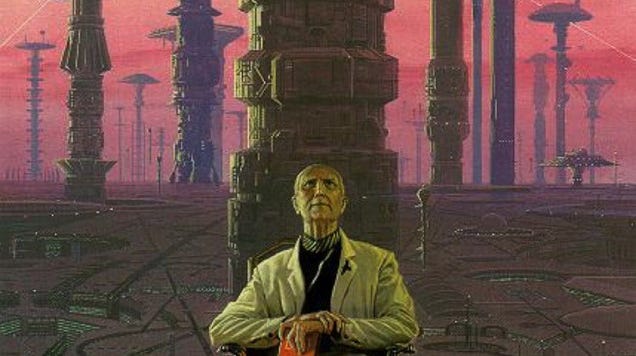
One of the most common criticisms that have been leveled at the Foundation Trilogy over the decades is Asimov’s premise that human behavior never changes. At the time of Foundation‘s publication, many science fiction writers already held to the idea that, with dynamic advances in technology and science, human nature itself would likewise be altered.
That idea has come into even sharper relief with the emergence of transhumanism—the concept that human beings will ultimately use technological and biological tools to alter the course of their own evolution. How could psychohistory predict behavior on a mass scale when its participants were no longer fully human?
The next part of Foundation touches upon that question, albeit in a more indirect way. Asimov introduces a character named the Mule—a mutant who possesses the mental ability to alter human emotions. He can turn adversaries into allies, transforming feelings of hatred into those of intense loyalty. Or he can inspire feelings of widespread fear and panic. The Mule uses these abilities to conquer the Foundation. In this case, the “dead hand of Hari Seldon” is of no help, since the science of psychohistory could never have anticipated the emergence of a mutant with these abilities. The Mule is the unpredictable variable in the equations of history.
The only ones who can defeat the Mule are the members of the secretive Second Foundation, which is only alluded to in the previous novels. The Second Foundation was established by Hari Seldon to continue and perfect his work—and develop the skills that will make them paramount in the mental sciences. As the head of the Second Foundation explains to a student:
Conditions have been so arranged and so maintained that in a millennium from its beginnings— six hundred years from now, a Second Galactic Empire will have been established in which Mankind will be ready for the leadership of Mental Science. In that same interval, the Second Foundation in its development, will have brought forth a group of Psychologists ready to assume leadership. Or, as I have myself often thought, the First Foundation supplies the physical framework of a single political unit, and the Second Foundation supplies the mental framework of a ready-made ruling class.
But, the defeat of the Mule has forced the Second Foundation to come out of hiding. The First Foundation is now aware of their influence, which threatens the Seldon Plan. As Asimov established at the very beginning of his narrative, psychohistory only works if the group being analyzed is unaware it’s being analyzed — because if it’s aware, the group changes its behavior. What’s more, there are members of the First Foundation who believe that a future where humanity is governed by the Second Foundation is hardly better than being ruled over by the Mule.
A complex plan is put into place, with the end result being that the First Foundation believes it has destroyed the Second Foundation, which, in fact, survives so that it can fulfill its destiny and that of humanity.
But Wait, There’s more…

The conclusion of the Foundation Trilogy proved to be a contentious one in the years following its publication. The takeaway is that humanity as a whole is incapable of change and therefore doesn’t possess free will. The only solution is a benevolent ruling class that can save us from ourselves.
In his introduction to a special 2012 edition of the Foundation Trilogy, Nobel Prize-Winning economist Paul Krugman wrote:
We never get to see the promised Second Empire, which may be just as well, because it probably wouldn’t be very likeable. Clearly, it’s not going to be a democracy— it’s going to be a mathematicized version of Plato’s Republic, in which the Guardians derive their virtue from the axioms of psychohistory. What this means for the books is that while a relatively bourgeois society may be the winner, Asimov is neither endorsing that society nor giving it a special long-run destiny. What this means for the storytelling is that the struggles don’t have to be and aren’t structured as a conventional tale of good guys versus villains, and the novels have that unexpected cynicism.
Yet, for some readers, as Wimmer and Wilkins observe, this conclusion left behind a “metaphysical hole.” Asimov strives to address that in his long-awaited sequel, Foundation’s Edge, which he published in 1982 (and which won the Hugo Award in 1983). In this standalone novel, set 500 years into the Foundation era, the First and Second Foundations both discover threats to their existence. The First Foundation has come to the conclusion that the Second Foundation was never actually destroyed; while the Second Foundation discovers evidence that they are being manipulated by an unknown group with similar abilities. (Sort of their version of the Dark Sith.)
Their respective missions bring them together to a world known as Gaia—a superorganism where all living creatures are part of a group consciousness, while still retaining their individual identities. This is revealed to be the true destiny of the human race, to become part of a vast shared consciousness forming an entity called Galaxia.
Fans remain as divided, if not more so, over the conclusion to Foundation’s Edge. On the one hand, Asimov pointedly addresses the themes he left dangling in the original trilogy. On the other hand, he put his own masterwork on trial and found it wanting.
In the years prior to his death in 1992, Asimov would write three more Foundation books—two prequels and a sequel. But, the Foundation Trilogy and, to a lesser extent, Foundation’s Edge, are considered the central works of the series.
Reportedly, Nolan’s focus will be on the original trilogy—although that doesn’t rule out the possibility that he’ll incorporate some characters and themes from the other books. But, the main question on everyone’s minds is whether this will this work as a TV series. There isn’t much action in the Foundation books, which are heavy on exposition and light on character development.
But Nolan’s devotion to the source material seems genuine — not least, because it clearly influenced his deft work on Person of Interest, a series built upon the premise of an artificial intelligence that can foresee threats. Unlike Hari Seldon, we’ll have to be content with waiting for the actual future of this project to unfold.
via io9.com

